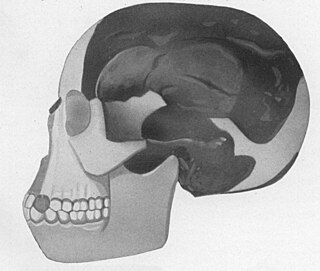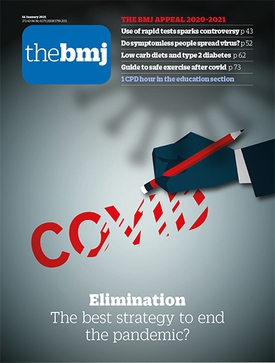Related Research Articles

Scientific misconduct is the violation of the standard codes of scholarly conduct and ethical behavior in the publication of professional scientific research. It is violation of scientific integrity: violation of the scientific method and of research ethics in science, including in the design, conduct, and reporting of research.

The BMJ is a weekly peer-reviewed medical journal, published by BMJ Group, which in turn is wholly-owned by the British Medical Association (BMA). The BMJ has editorial freedom from the BMA. It is one of the world's oldest general medical journals. Previously called the British Medical Journal, the title was officially shortened to BMJ in 1988, and then changed to The BMJ in 2014. The journal is published by BMJ Publishing Group Ltd, a subsidiary of the British Medical Association (BMA). The current editor-in-chief of The BMJ is Kamran Abbasi, who was appointed in January 2022.

JAMA (The Journal of the American Medical Association) is a peer-reviewed medical journal published 48 times a year by the American Medical Association. It publishes original research, reviews, and editorials covering all aspects of biomedicine. The journal was established in 1883 with Nathan Smith Davis as the founding editor. Kirsten Bibbins-Domingo of the University of California San Francisco became the journal editor-in-chief on July 1, 2022, succeeding Howard Bauchner of Boston University.

The Canadian Medical Association Journal is a peer-reviewed open-access general medical journal published by the Canadian Medical Association. It publishes original clinical research, analyses and reviews, news, practice updates, and editorials.
Medscape is a website providing access to medical information for clinicians and medical scientists; the organization also provides continuing education for physicians and other health professionals. It references medical journal articles, Continuing Medical Education (CME), a version of the National Library of Medicine's MEDLINE database, medical news, and drug information. At one time Medscape published seven electronic peer reviewed journals.

The ICMJE recommendations are a set of guidelines produced by the International Committee of Medical Journal Editors for standardising the ethics, preparation and formatting of manuscripts submitted to biomedical journals for publication. Compliance with the ICMJE recommendations is required by most leading biomedical journals. Levels of real compliance are subject to debate. As of 9 January 2020, 5570 journals worldwide claim to follow the ICMJE recommendations.
George D. Lundberg is an American board-certified pathologist and writer.
The Vancouver system, also known as Vancouver reference style or the author–number system, is a citation style that uses numbers within the text that refer to numbered entries in the reference list. It is popular in the physical sciences and is one of two referencing systems normally used in medicine, the other being the author–date, or "Harvard", system. Vancouver style is used by MEDLINE and PubMed.
AuthorAID is the name given to a number of initiatives that provide support to researchers from developing countries in preparing academic articles for publication in peer-reviewed journals. Phyllis Freeman and Anthony Robbins, co-editors of the Journal of Public Health Policy (JPHP), first suggested the name and concept in 2004 and published "Closing the ‘publishing gap’ between rich and poor" about AuthorAID on the Science and Development Network (SciDev.Net), in 2005.
Open peer review is the various possible modifications of the traditional scholarly peer review process. The three most common modifications to which the term is applied are:
- Open identities: Authors and reviewers are aware of each other's identity.
- Open reports: Review reports are published alongside the relevant article.
- Open participation: The wider community are able to contribute to the review process.
Fiona Godlee was editor in chief of The British Medical Journal from March 2005 until 31 December 2021; she was the first female editor appointed in the journal's history. She was also editorial director of the other journals in BMJ's portfolio.

Medical journalism is news reporting of medical news and features. Medical journalism is diverse and reflects its audience. The main division is into (1) medical journalism for the general public, which includes medical coverage in general news publications and in specialty medical publications, and (2) medical journalism for doctors and other professionals, which often appears in peer-reviewed journals.
Medical ghostwriters are employed by pharmaceutical companies and medical-device manufacturers to produce apparently independent manuscripts for peer-reviewed journals, conference presentations and other communications. Physicians and other scientists are paid to attach their names to the manuscripts as though they had authored them. The named authors may have had little or no involvement in the research or writing process.
A medical journal is a peer-reviewed scientific journal that communicates medical information to physicians, other health professionals. Journals that cover many medical specialties are sometimes called general medical journals.
Bullying in the medical profession is common, particularly of student or trainee physicians. It is thought that this is at least in part an outcome of conservative traditional hierarchical structures and teaching methods in the medical profession which may result in a bullying cycle.

Drummond Rennie is an American nephrologist and high altitude physiologist who is a contributing deputy editor of The Journal of the American Medical Association (JAMA) and an adjunct professor of medicine at the University of California, San Francisco.
Individual participant data is raw data from individual participants, and is often used in the context of meta-analysis.

Conflicts of interest (COIs) often arise in academic publishing. Such conflicts may cause wrongdoing and make it more likely. Ethical standards in academic publishing exist to avoid and deal with conflicts of interest, and the field continues to develop new standards. Standards vary between journals and are unevenly applied. According to the International Committee of Medical Journal Editors, "[a]uthors have a responsibility to evaluate the integrity, history, practices and reputation of the journals to which they submit manuscripts".
Preregistration is the practice of registering the hypotheses, methods, or analyses of a scientific study before it is conducted. Clinical trial registration is similar, although it may not require the registration of a study's analysis protocol. Finally, registered reports include the peer review and in principle acceptance of a study protocol prior to data collection.
Journalology is the scholarly study of all aspects of the academic publishing process. The field seeks to improve the quality of scholarly research by implementing evidence-based practices in academic publishing. The term "journalology" was coined by Stephen Lock, the former editor-in-chief of the BMJ. The first Peer Review Congress, held in 1989 in Chicago, Illinois, is considered a pivotal moment in the founding of journalology as a distinct field. The field of journalology has been influential in pushing for study pre-registration in science, particularly in clinical trials. Clinical trial registration is now expected in most countries. Journalology researchers also work to reform the peer review process.
References
- ↑ "About Us". WAME. Retrieved 2019-05-18.
- 1 2 Squires, Bruce; Fletcher, Suzanne (January–February 2005). "The World Association of Medical Editors (WAME): Thriving in Its First Decade" (PDF). Science Editor. 28 (1): 13–16. Archived from the original (PDF) on 2020-03-27. Retrieved 2019-05-18.
- ↑ Wager, Elizabeth (2005). Getting Research Published: An A to Z of Publication Strategy. Radcliffe Publishing. p. 113. ISBN 9781857756876.
- ↑ Weller, Ann C. (2001). Editorial Peer Review: Its Strengths and Weaknesses. Information Today, Inc. p. 14. ISBN 9781573871006.
- ↑ "Launch of the World Association of Medical Editors". JAMA: The Journal of the American Medical Association. 273 (13): 981. 1995-04-05. doi:10.1001/jama.1995.03520370019006. ISSN 0098-7484.
- ↑ Smith, R. (1995-03-25). "World Association of Medical Editors (WAME) launched". BMJ. 310 (6982): 761–762. doi:10.1136/bmj.310.6982.761a. ISSN 0959-8138. S2CID 75748830.
- ↑ Ferris, Lorraine E.; Fletcher, Robert H. (2012-05-09). "Conflict of interest in Peer-Reviewed medical journals: The World Association of Medical Editors (WAME) position on a challenging problem". Cardiovascular Diagnosis and Therapy. 2 (3): 188–191–191. doi:10.3978/j.issn.2223-3652.2012.07.03. ISSN 2223-3660. PMC 3839187 . PMID 24282716.